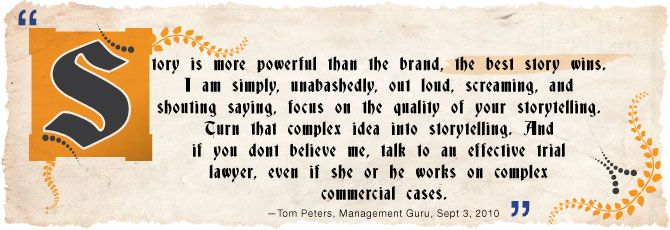
A couple of years ago while at a conference in California, I met Simon Kelly, the Chief Enthusiasm Officer at Story Worldwide. We sat on the same content marketing panel. At one point, he leaned over to me and handed me his business card. I took one look, and knew it was a keeper. It stood out so much that to this day I still have it tacked above my credenza. The funny thing is the back of his business card faces out. You want to know why?
Because printed on the back it says:

Whenever I look over at this card, I smile and remind myself that it’s all about telling a great story. People love stories. When we share our lives with one another, it’s through stories. We meet over coffee to talk about what happened to us at work; we call our friend up to tell a story about our fun night last night. Compelling stories persuade and even have the power to change deeply-held beliefs. To really engage your audience, deliver stories that they want to read, watch or hear — stories they want to be a part of and will enjoy so much, that they will be inspired to share them.
“Story is more powerful than the brand, the best story wins. I am — simply, unabashedly, out loud, screaming, and shouting — saying, focus on the quality of your storytelling. Turn that complex idea into storytelling. And if you don’t believe me, talk to an effective trial lawyer, even if she or he works on complex commercial cases.”
—Tom Peters, Management Guru, Sept 3, 2010
One of the fundamental goals of content marketing, of all advertising, is to create fans that will spread your stories for free, lowering your marketing expenses. Content that appeals to our social nature is ideal for storytelling, so find the stories about your employees, your company, your services and your products and tell them! Below are five tips to help you improve your storytelling.
Your Personal Experiences:
One of the best places to start is by turning personal experiences into stories. This requires a bit of confidence and maybe a little imagination, however once you work through turning a couple of yourreal life experiences into stories, it will start to come naturally. Of course sharing these experiences requires you to be willing to let them become public. After you become comfortable with it, you should work to build a small collection that you can adapt to complement and enhance presentations on a range of topics.Observe Presenters Telling Stories:
Professional presenters regularly use stories in their presentations and content. When you see a professional presenter, think about their use of stories. There are many reasons to use stories including; provide humor, make points memorable, identify with the particular audience, inspire people to act, build a shared vision, and to relieve tension.Learn What Makes A Good Story:
By observing others work, take the time to learn what makes a good story, one that people can learn from and relate to. You might look for the following; it is told well, the presenter is sincere, it fits the occasion, and the audience can relate to the story.Constantly Collect Stories:
Stories abound in our everyday world. Keep a notebook (electronic or otherwise) to keep track of your ideas and stories you like. When you know a good story, sooner or later you will find a way to include it into a presentation. Here is a great post covering 29 ways to stay creative.Use Video:
If you have been following this blog for any time at all, you know we highly encourage the use of video. Check out this story about the power of words:
Would love to hear of some great “story telling” examples out there!
No comments:
Post a Comment